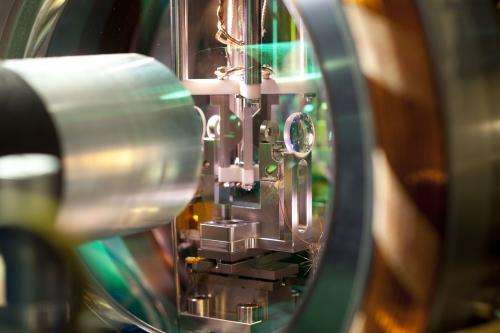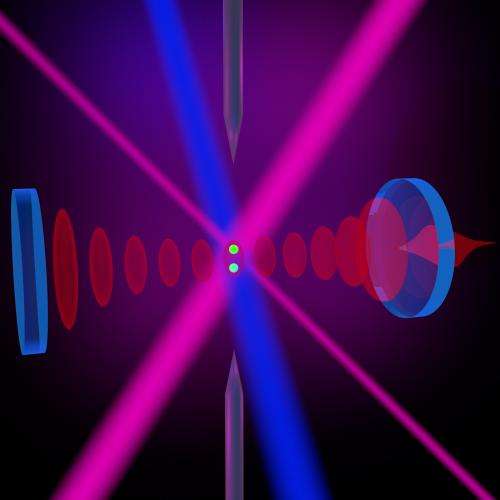Improved interface for a quantum internet

A quantum network requires efficient interfaces over which information can be transferred from matter to light and back. In the current issue of Physical Review Letters, Innsbruck physicists led by Rainer Blatt and Tracy Northup show how this information transfer can be optimized by taking advantage of a collective quantum phenomenon.
Quantum computers are no longer just a theoretical concept. In recent years, researchers have assembled and successfully tested the building blocks for a future quantum computer in the laboratory. More than a dozen candidate technologies are currently being studied; of these, ion traps are arguably the most advanced. In an ion trap, single atoms can be confined and precisely controlled by means of lasers. This idea was developed by theorists Ignacio Cirac and Peter Zoller, and a team of Innsbruck experimental physicists under Rainer Blatt has been at the forefront of its implementation. Based at the University of Innsbruck's Institute for Experimental Physics, the team first demonstrated in 2013 that quantum information stored in a trapped ion can be deterministically mapped onto a photon, that is, a quantum of light. Thus, they were able to construct an interface between quantum processors and optical fiber-based communication channels. Now the physicists have improved this interface, making use of so-called superradiant states.
A reliable interface
"In order to build a quantum network with trapped ions, we need an efficient interface that will allow us to transfer quantum information from ions to photons," explains Tracy Northup, project leader in Rainer Blatt's team. "In our interface, we position two ions between two highly reflective mirrors, which form an optical resonator. We entangle the ions with one another and couple both of them to the resonator." The collective interaction between the particles and the resonator can now be tuned in order to enhance the creation of single photons. "This is known as a superradiant state," explains Bernardo Casabone, the article's first author. In order to demonstrate that the interface is well suited for quantum information processing, the researchers encode a quantum state in the entangled particles and transfer this state onto a single photon. Because of the superradiant interaction, the photon is generated almost twice as quickly as in their previous experiment. "Thanks to superradiance, the process of information transfer from the particle to the photon essentially becomes more robust," Casabone emphasizes. As a consequence, the technical requirements for the construction of accurate interfaces may be relaxed.

Read–write capabilities for a quantum memory
In the same experiments on light–matter interactions, the Innsbuck physicists were also able to create so-called subradiant states. Here, the emission of a photon is suppressed rather than enhanced. "These states are also interesting because the stored information becomes invisible to the resonator, and in that sense, it's protected," says Northup. As a result, one can imagine that by switching between sub- and superradiant states, quantum information can be stored in ions and retrieved as photons. In a future quantum computer, such addressable read–write operations may be achieved for a quantum register of trapped ions.
More information: "Enhanced quantum interface with collective ion-cavity coupling." DOI: 10.1103/PhysRevLett.114.023602
Journal information: Physical Review Letters
Provided by University of Innsbruck




















